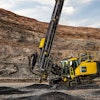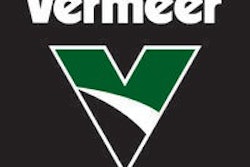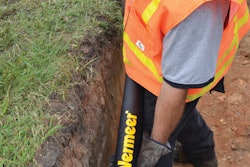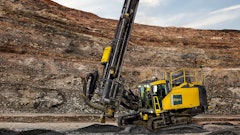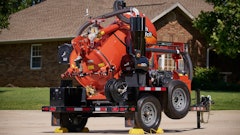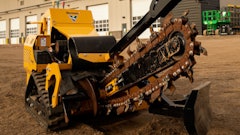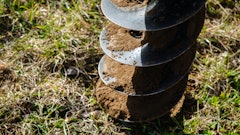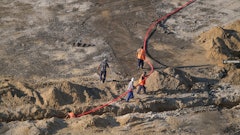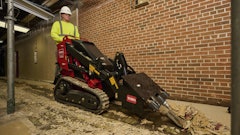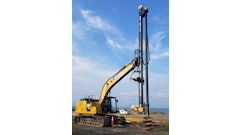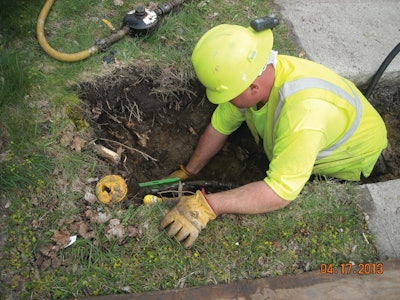
Laying flexible natural gas lines is a part of everyday working life for the 15 crews of M. O’Herron Co., Pittsburg, PA. As a utility contractor for the city of Pittsburgh and Allegheny County, M. O’Herron Co. has installed more than 1,000 miles of 2- to 24-in. gas mains and services for the region’s three local gas utility companies over the last 50 years.
A recent job in a residential neighborhood required installing several miles of underground 2-in. flexible natural gas lines.
“The job called for boring under each resident’s driveway,” notes Tim Kretzler, construction supervisor. “Excavating through these driveways via open trenching was not allowed. Open cutting is always a quicker option for us, but it’s not always the most cost effective for our employers. In today’s economy, everyone is looking to save money and trenchless technology is one of the ways to do that.”
Designed to Handle Varying Conditions
A 3-in. Vermeer Hole Hammer pneumatic piercing tool proved essential to Kretzler and his crews on this residential project. As one of the first to try out the new trenchless tool, the crews used a prototype on more than 300 shots for approximately four months.
The Hole Hammer is designed to operate in a full range of soil conditions, which came in handy with the loose soil encountered under many of the driveways. In these conditions, as the piston on the piercing tool comes backward, there can be a tendency to drag the entire tool assembly backward. This process, known as swimming, leaves the tool shaking underground instead of moving in a constant direction. The Hole Hammer features a ribbed tool body that provides additional grip for traction in loose soil, helping achieve forward impact on each blow.
“The ribbing feature is unique in pneumatic piercing tools. None of the tools I have worked with before have this feature,” says Kretzler. “The ribbing allowed us to work faster because the tool maintained one direction throughout the job. It didn’t slow down in softer material, so we could finish up one driveway, move on to the next, dig our spot holes and begin boring.”
Another time-saving benefit is the quarter-turn reverse function, which allows the operator to reverse the tool quickly, even with the air on. This feature eliminates the need to shut the tool down to reverse direction, helping to reduce time spent on underground restarts.
To further adapt to conditions, the Hole Hammer comes with interchangeable heads. The standard replaceable head is used in conditions where production of 1 fpm is required. In rocky soil conditions or when production begins to diminish, a moving head assembly can be installed by unthreading the nose.
“It wasn’t necessary for us to change heads with the jobs we performed with this prototype, but I can see these interchangeable heads being a useful feature,” Kretzler says. “It would certainly be more cost effective for a contractor to purchase one pneumatic piercing tool with interchangeable heads than several separate tools.”
A Productive Outcome
In his many years on jobsites, Kretzler has tried his share of pneumatic piercing tools. “I’m what you would call an experienced operator,” he says. “I’ve tried almost all the makes and models over the years.”
He was impressed with the Hole Hammer’s performance. “It was one of the straightest shooting tools that we’ve used in recent years and we’ve probably tried more than 30 pneumatic piercing tools in that time frame,” he states.
One modification made to the prototype was adding a swivel fitting where the hose attaches to the oiler to prevent the tool from accidentally going into reverse. “When pressure built up in the hose and the hose curled up and twisted the wrong way, [the tool] did jump into reverse on us a few times, so we added the swivel connection,” Kretzler recalls. “Vermeer did modify the tool for production after the testing process. The company changed the spring tension on the system, as well.”
Overall, the crews of M. O’Herron Co. had a positive experience with the new trenchless tool. “The industry can use a tool like this. It’s an improvement on existing technology for all of us gophers,” Kretzler asserts. “And there isn’t a premium price for this new tool. Vermeer is offering this model at the same price as its standard piercing tool lineup. Based on our experience with the prototype, I would choose this Hole Hammer for future jobs.”


